Job Analysis, Job Design & Human Resources Planning

Job analysis, job design and human resources planning are the functions of HR that seek to address the gaps between the tasks that need to be performed for an organization to function properly and the available human resources in the market. They not only seek to bring the above two together but also ensure to bring harmony in their coexistence. Let’s begin to look at these functions individually, in more detail.
Job Analysis
This function identifies all the tasks that need to be performed in an organization in consultation with the line managers. Not only simply identifying the tasks, but also clubbing them together for one person to do them, thus creating a position. After the creation of a position, duties and responsibilities are identified that the incumbent must discharge in order to accomplish those tasks assigned to the position in question. This complete one side of the job analysis, which is called Job Description.
Going further, now it is important to identify the right set of Knowledge, Skills & Attitude (KSA) that the incumbent must possess to carry out the job as described in the job description. Educational qualifications, work experience, additional skills and attitude are clearly spelt out for right candidate. These requirements are classified as Job Specifications. This process of understanding the tasks and matching them with the right human resource is called Job Analysis.
Important Terminology in Job Analysis
- Job – Task(s) that need to be carried out for the smooth functioning of an organization.
- Position – Collection of tasks and responsibilities performed by one person; there is a position for every individual in an organization.
- Job Description – Details of the tasks, responsibilities and the duties to be carried out at a particular position.
- Job Specification -Describes the abilities of the candidate(s) to be considered for a certain position.
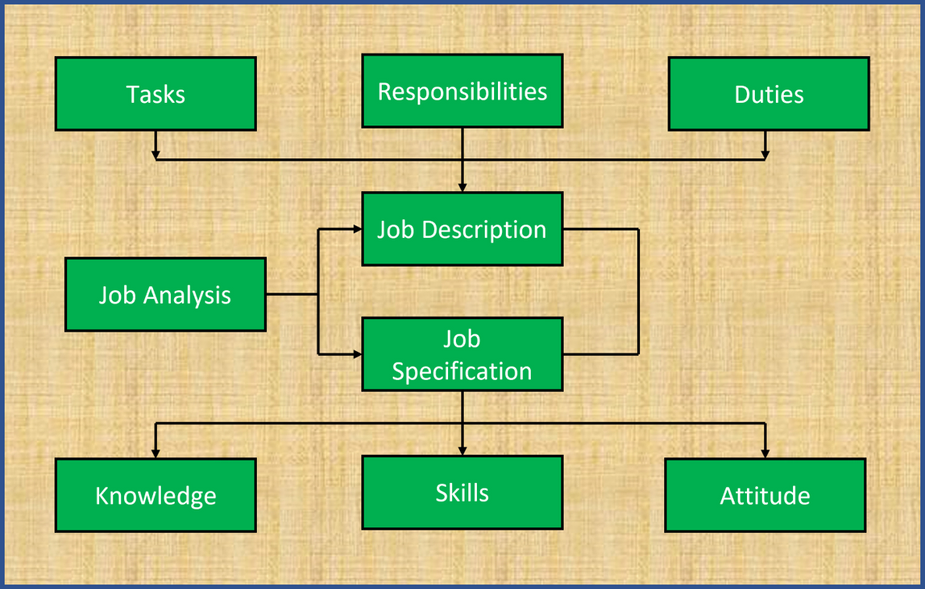
Example: Lets carry the job analysis of an airline pilot
- Tasks – Fly the plan, perform all safety checks, address all the compliance requirements.
- Duties – To check the airworthiness of an airplane, conduct pre-flight checks, file the flight plan with air traffic control, fly the plane from point A to point B, update the necessary log books.
- Responsibilities – Responsible for safe flight between starting location and the destination location. Ensure all log books are filled within the approved time frame. Overall custodian of passengers and crew while the aircraft is in flight.
- The above tasks, duties and responsibilities when presented together are called job specifications.
- Knowledge – Educational Qualifications, technical qualifications required to be an airline pilot.
- Skills – Requirement of certain number of hours of flying experience, night flying expertise etc.
- Attitude – Sense of responsibility, liking for the job, discipline etc.
These KSAs form the job specifications. Together, Job Descriptions and Job Specifications identified here conclude the Job Analysis of the position of an airline pilot. Obviously, there would be far more details both in Job Description and Job Specifications for an airline pilot. The above example is simply meant to demonstrate the concept of Job Analysis.
Also Read – Compensation Management | Key to Organizational Productivity and Success
Information Needed For Job Analysis
• Worker oriented activities
• Machines, tools, equipment, and work aids used
• Job-related tangibles and intangibles
• Work performance
• Job content
• Personal/Personnel requirements for the job
Sources of Information
- Direct Observation – In this method, the employee is observed while he is working and questions are asked as he performs i.e., job analysis takes place right on the job. This method results in a complete job description. However, it is a slow method that may interfere with normal work operations.
- Questionnaire Method – In this method the worker is given a questionnaire and he himself provides data about himself and his job. This method is only good for workers who are not only literate but can also express themselves well and not for low level workers lacking writing skills. Also, the analysis of data obtained thus is very laborious and time consuming.
- Consultation With Technical Experts – Experts on the job in question are the source of information in this method. Usually, supervisors having extensive knowledge of the job in question are asked to specify all the characteristics of the job. Data obtained thus may not reflect the accurate picture as it is provided by experts only from their estimate and not from being on the job themselves.
- Group Interview Methods – n this method, a group of workers are interviewed simultaneously. By recalling and discussing their work activities, they provide data about the job in question. Time saved and greater recall is the advantages of this method.
- Work Participation Method – In this method, the job analyst himself performs the jobs thereby and gets firsthand information about the characteristics of the job in question. For simple jobs, this technique is effect, but complex jobs need specialized training which the analyst may or may not possess.
- Time & Motion Studies -n this method, the speed of an individual worker in performing a particular job and time consumed therein are both noted down. The same observations are made for other individuals while doing the same job. Then the results obtained are compared. Workers can be classified with the help of this type of study of speed and time and the data can be used for job analysis.
Related – Human Resources Management, An Introduction
Job Design
Job design is a process of designing or redesigning a job landscape to ensure that the organization achieves its goals and objectives, while also ensuring maximum motivation and ownership from the employees.
Components of Job Design
- Job Simplification – Analyzing the number and nature of activities performed at given position to see if some of the activities can be eliminated, giving more room to an employee to focus on fewer activities.
- Job Rotation – Placing employees in different functions and departments by rotation to ensure cross skilling and to reduce boredom.
- Job Enrichment – Adding higher responsibilities to an employee’s job description to offer new challenges and opportunities to the employee to show his capabilities.
- Job Enlargement – Opposite of job simplification, where more lateral tasks are added to the job description of a position to either enhance financial gains or to bring variety to a position’s job roles.
- Ergonomics – Creating a workplace that lowers employee fatigue, both physical and mental. Chairs with lumbar support, ergonomic keyboards with palm rest, comfortable lighting etc, are a few examples.
- Flexi Timings – Every human has a different circadian rhythm, making them productive at different times of the day or night. Recognizing this difference across the human race, many companies are allowing their employees to follow their own schedules instead of having to work in tightly scripted timelines. This results in higher productivity and higher motivation as well!!
- Flexi Locations – Mostly and outcome of the pandemic, companies have come to realize that it is not necessary for many job positions to be located in the office premises. Now employees are being offered the flexibility of working from anywhere as long as it does not hamper their productivity.
- Safety – Workplace safety is an important hygiene factor and issues like fire safety, safety of women, safety from intimidation and fraud are some of the pointers towards workplace safety.
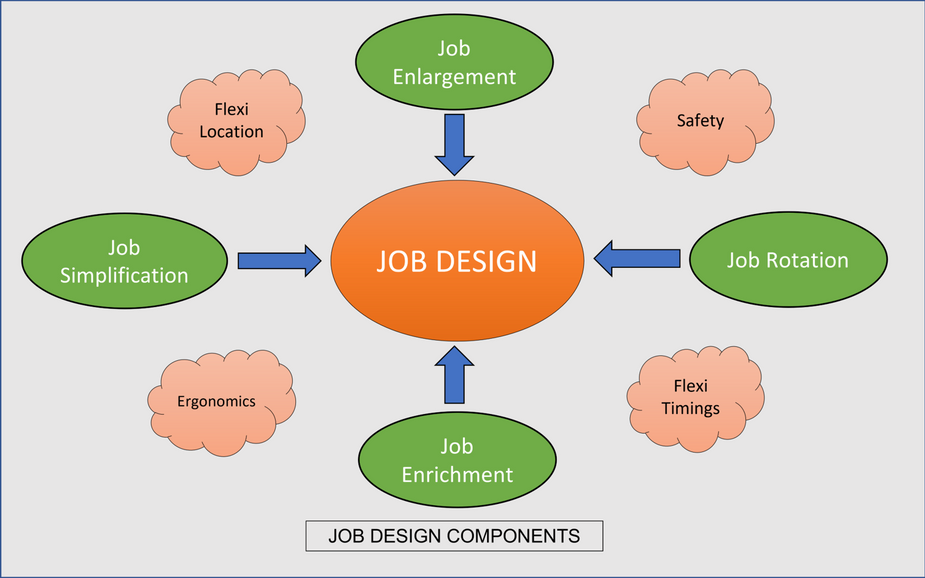
Benefits of Job Design
• Higher Productivity
• Lower Costs
• Better Quality
• Employee Motivation
• Lower Absenteeism
• Lower Employee Attrition
• Better Safety At Workplace
Human Resources Planning
The process of systematically reviewing HR requirements to ensure the availability of talent as per the current and emerging requirements, both quantitatively and qualitatively, to support the strategic quest of an organization.
HRP ensures that the organization always operates at the optimum levels of talent. Too less talent will result in compromised quality and quantity and too much talent will affect profitability and cause benching of employees. Optimal levels are determined both from quantitative and qualitative viewpoints.
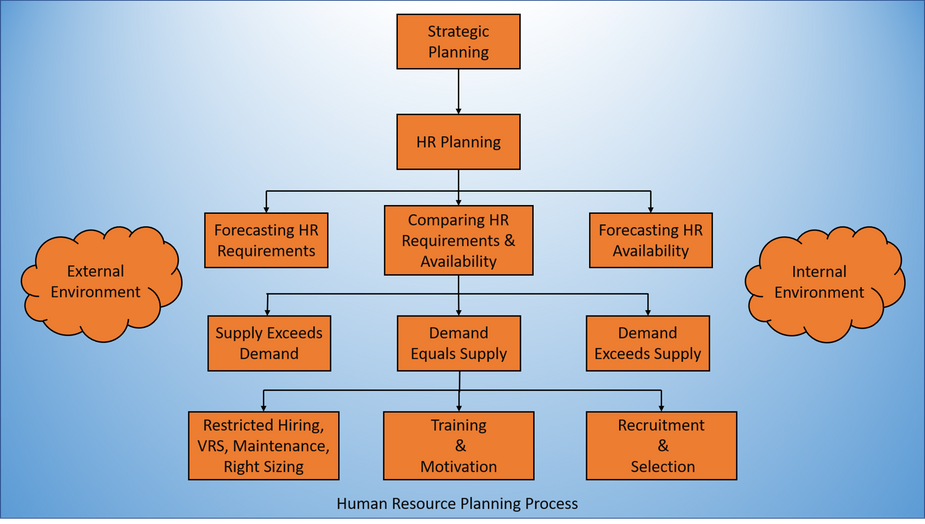
Sources of Information for Forecasting HR Demand
External Factors
• PESTLE
• Competition
Organizational Factors
• Strategy
• Expansion Plans
• New Ventures
• Sales Forecasts
Workforce
• Superannuation
• Leaves & Absence
• Attrition
Sources of Information for Forecasting HR Supply
External
• Demographics
• Attitudes
• Labor Market Trends
Internal
• Succession Planning
• Current Workforce
• Referrals
Methods to Deals with HR Surplus
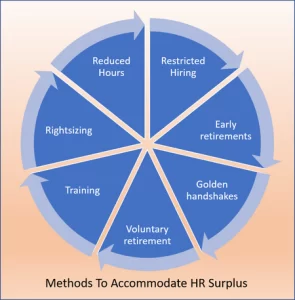
- Restricted Hiring – When faced with surplus employees, many companies put their hiring process on hold till the workforce levels match with the planned levels.
- Early Retirements – If an organization faces employee surplus, it can encourage early retirements by offering golden handshakes, voluntary retirement schemes etc. to offer a graceful and monetarily practical exit route for senior employees. This helps in bring down the employee count gracefully and quickly.
- Training – When faced with surplus workforce temporarily, organizations utilize the opportunity to take some employees off their regular duties and train them for new skills, thus enriching the skill pool of the organization.
- Rightsizing – This is the last option where pink slips are handed out to employees to bring down the employee count to acceptable levels. This is generally used only in extreme cases where due to sudden and unforeseen circumstances, the company is facing a high employee surplus. Care is taken to select the outgoing employees and it is ensured that the entire process is made graceful and dignified as far as possible to avoid psychological issues cropping up.
- Reduced Hours – For temporary HR surplus situations, many companies these days are giving mandatory breaks to their employees or reducing their working hours to maintain only optimum workforce in the office. This enhances employee morale and can easily be reversed when more employees are needed back at the office.
Related – Talent Acquisition – Supporting The Corporate Strategy
Methods to Deal With HR Shortage
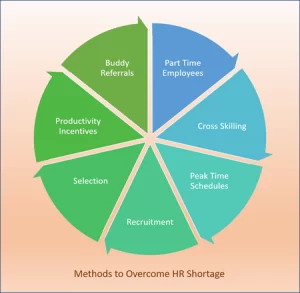
- Recruitment – Most obvious method to deal with HR is going into a recruitment overdrive to fill up vacant positions fast. This however also depends upon the availability of resources in the market.
- Part Time Employees – Industries that have erratic work routines, like the hospitality, Recruitment – Most obvious method to deal with HR is going into a recruitment overdrive to fill up vacant positions fast. This however also depends upon the availability of resources in the market.
- Part Time Employees – Industries that have erratic work routines, like the travel and tourism industries, companies rely on part time employees instead of recruiting full timers to tide over uncertain and temporary surges in business.
- Cross Skilling – Employees are trained in majority of an organization’s functions whenever there is an opportunity. Later, whenever required, these cross trained employees can fill up manpower gaps easily without having to recruit new people.
- Peak time schedules – Again in industries like hospitality, aviation and seasonal tourism, employees from staff functions such as finance, HR, administration etc., are called upon to work alongside their line counterparts, thus reducing the need to recruit additional employees for only peak time surges.
- Productivity Incentives – In order to tide over minor or temporary HR shortages, paying overtime or incentives for better productivity can be effective methods deal with such situations.
- Referrals – Finally, in order to recruit and select good quality talent, employee referral schemes can be useful in attracting talent. It is a two-pronged HR strategy. On hand the company ends up acquiring good talent, secondly, instead of paying outside placement agencies, internally referring employees earn the referral bonus that might enhance their engagement with the company further.
“You can take away my factories, burn my buildings, but given me back my people and I will build it up all over again”– Henry Ford









